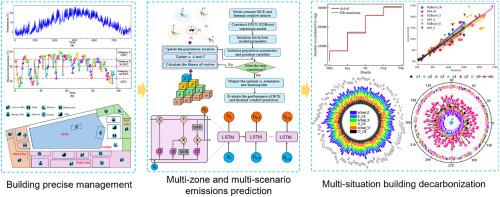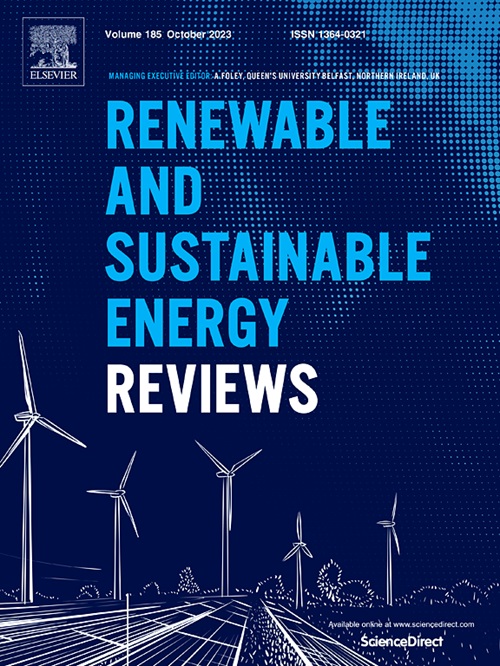Zone-based many-objective building decarbonization considering outdoor temperature and occupation uncertainty
IF 16.3
1区 工程技术
Q1 ENERGY & FUELS
引用次数: 0
Abstract
Operational building decarbonization is challenging due to complex weather conditions and occupation uncertainty. This paper introduces a precise optimization framework integrating the building information modelling technique and intelligent algorithms to dynamically predict multi-scenario building carbon emissions and optimize the building emissions performance considering building zones and weather conditions. Firstly, the on-site data and building information modeling-supported building emissions simulation data are collected for model training. Secondly, using intelligent algorithms, zone-based hourly carbon emissions and multi-scenario carbon emissions prediction are conducted simultaneously. Thirdly, the optimal decarbonization strategies are conducted using intelligent algorithms under various weather conditions. This framework has been verified for decarbonization in a high-rise operational building. The results reveal that: (1) The carbon emissions prediction is highly consistent with the ground truth after considering the sub-zone correlations; the R2 for the west, south, and east zones are 0.900, 0.900, and 0.942, respectively; (2) The surrogate models can accurately predict carbon emissions and thermal comforts with all R2 are higher than 0.912. The optimization rate of the building reaches 59.2 % while the outdoor temperature is above 35 °C. (3) In the many-objective optimization model, considering occupation uncertainty makes the strategy close to the actual situation, reaching the decarbonization by 6815.23 kg compared to the empirical operation for the cooling period. This work provides a new path for operational building precise management and control-oriented optimization decarbonization.

考虑室外温度和占用率的不确定性,基于分区的多目标建筑脱碳技术
由于复杂的天气条件和入驻的不确定性,运行中的建筑脱碳具有挑战性。本文介绍了一种整合建筑信息模型技术和智能算法的精确优化框架,以动态预测多情景建筑碳排放,并优化考虑建筑分区和天气条件的建筑排放性能。首先,收集现场数据和建筑信息模型支持的建筑排放模拟数据进行模型训练。其次,利用智能算法,同时进行基于分区的每小时碳排放和多情景碳排放预测。第三,利用智能算法在各种天气条件下进行最优去碳策略。该框架已在一栋高层运行建筑中进行了脱碳验证。结果表明(1)考虑分区相关性后,碳排放预测与地面实况高度一致,西区、南区和东区的 R2 分别为 0.900、0.900 和 0.942;(2)代用模型能够准确预测碳排放和热舒适度,所有 R2 均大于 0.912。当室外温度高于 35 ℃ 时,建筑物的优化率达到 59.2%。(3)在多目标优化模型中,考虑占用的不确定性,使策略接近实际情况,与制冷期的经验操作相比,达到了 6815.23 千克的脱碳量。这项工作为运行楼宇精确管理和以控制为导向的优化脱碳提供了一条新路径。
本文章由计算机程序翻译,如有差异,请以英文原文为准。
求助全文
约1分钟内获得全文
求助全文
来源期刊

Renewable and Sustainable Energy Reviews
工程技术-能源与燃料
CiteScore
31.20
自引率
5.70%
发文量
1055
审稿时长
62 days
期刊介绍:
The mission of Renewable and Sustainable Energy Reviews is to disseminate the most compelling and pertinent critical insights in renewable and sustainable energy, fostering collaboration among the research community, private sector, and policy and decision makers. The journal aims to exchange challenges, solutions, innovative concepts, and technologies, contributing to sustainable development, the transition to a low-carbon future, and the attainment of emissions targets outlined by the United Nations Framework Convention on Climate Change.
Renewable and Sustainable Energy Reviews publishes a diverse range of content, including review papers, original research, case studies, and analyses of new technologies, all featuring a substantial review component such as critique, comparison, or analysis. Introducing a distinctive paper type, Expert Insights, the journal presents commissioned mini-reviews authored by field leaders, addressing topics of significant interest. Case studies undergo consideration only if they showcase the work's applicability to other regions or contribute valuable insights to the broader field of renewable and sustainable energy. Notably, a bibliographic or literature review lacking critical analysis is deemed unsuitable for publication.
 求助内容:
求助内容: 应助结果提醒方式:
应助结果提醒方式:


